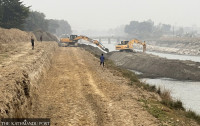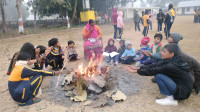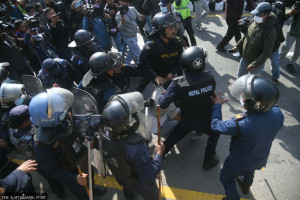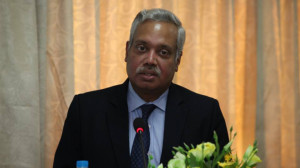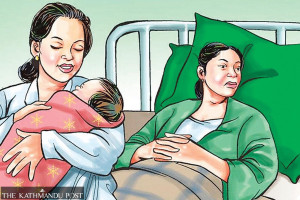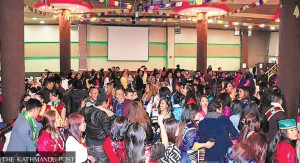National
Injured Gen Z protest victims call for justice
Survivors of the September demonstrations continue to battle severe injuries while calling for the arrest of those responsible and government action to ensure accountability.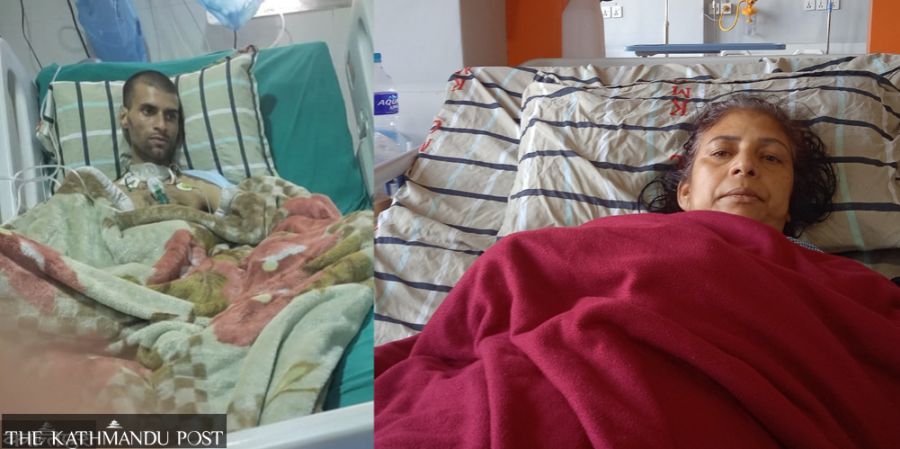
Samarpan Shree
Forty-eight-year-old Geeta Sah lay in agony in the plastic surgery ward of Kathmandu Medical College in Sinamangal, her body scarred by burns. More than six weeks had passed since she was admitted. Though her wounds were slowly healing, the trauma of that day continued to torment her.
During the Gen Z protest on September 9, Geeta stepped out of her watch and eyewear shop in Koteshwar. At first, the situation seemed calm, but chaos quickly erupted. Protesters violently attacked police officers. Seeing them beaten and bleeding, Geeta rushed forward, pleading with the crowd to stop. In that moment, someone hurled acid meant for the police—it struck her instead. The burns covered her right hand, leg, and abdomen. The memory continues to haunt her.
“I had stepped out to watch the protest,” she recalled. “Three or four police officers were still on the rooftop, while the rest had already fled. When the police fired two warning shots to defend themselves, the protesters set the post on fire.”
“The flames spread quickly. As the officers tried to escape, the protesters dragged them onto the roof, beat them severely, and threw them onto the street below,” Sah added.
Seeing a police officer being beaten to death, she pleaded with the crowd to stop. “Please, stop—let them go,” she said.
One officer, fearing for his life, clutched her leg and cried, “Mother, please save me.” A protester yelled at her to leave. She begged again: “Please, let them go. It’s enough.” A protester shot back, “You showed no pity when others’ sons were killed; why pity him now?” “Every life is the same,” Geeta said.
At that moment, a protester hurled acid. It struck her, burning her right hand, and she tore off her clothes in panic.
Even then, the police officer clung to Geeta’s leg, still pleading for help. But by then, her own life was in grave danger. The burns spread from her legs to her abdomen. At that moment, her son’s friend arrived on a scooter and rushed her to Kantipur Hospital. Seeing the risk of fire there as well, they transferred her to KMC Hospital, where she spent two weeks in the ICU.
Geeta’s 26-year-old son, Rahul, recalled that day: “I was also at the protest in Baneshwar, even though Mom had told me not to go. Later, she called, asking me to come quickly. Then Dad called and said her legs were on fire. Seeing Mom at the hospital, I just couldn’t handle it.”
While at the hospital, Rahul grows increasingly anxious. “It’s hard seeing Mom, who always looks after us, suffer like this,” he said. He is furious with the person responsible. “I’ve told the police. The one who threw the acid must be arrested,” Rahul said, his voice heavy with pain.
At KMC’s HCU ward, 27-year-old Kamal Ghimire from Bethanchok, Kavre, is still struggling to recover from his injuries. On Sunday, he finally shared the details with his uncle, Prananath Ghimire. “I was filming the scene. Then, suddenly, I was shot,” Kamal said.
Kamal, who owned a cow farm in Radheradhe, went to his dairy on the morning of September 8, heading straight to the protest instead. He was shot in the left shoulder, and the bullet also damaged his lungs. “He spoke a little yesterday, but today he cannot speak at all,” his uncle Prananath said, worried.
Kamal had been the backbone of the family. When he was injured, his parents collapsed in shock. “Since my elder brother and sister-in-law were in trauma when they arrived, I’ve stayed at the hospital from day one,” Prananath said. He criticises the government for its absence. “Prime Minister Sushila Karki, who came to power on the blood of our own children, visited other places but never came here to console us,” he said. “Even now, those who opened fire during the protest haven’t been arrested. What is holding them back?”
Twenty-nine-year-old Rabi Bhandari, being treated at B&B Hospital in Satdobato, was referred from KMC Hospital 20 days ago. He is now anxious, thinking about the crumbling state of his family. Rabi’s home is in Sindhuli, but he was living temporarily in Tikathali. Five years ago, he returned from a job in Qatar and had been running a local transport business, using the earnings to repay his family’s debts and fund his younger brother’s education.
After the Gen Z protest, he has been distressed. He did not join the protest the previous day, but his brother went and returned home having lost a friend in the chaos. Fueled by anger, Rabi joined the protest the next day. “We were at Maharajgunj. Another group was heading toward Gongabu, setting police posts on fire. I moved forward with them. Just before Bhatbhateni, I was shot in both legs,” he recalls.
Rabi says the government formed after the Gen Z protest should not only ensure treatment for the injured but also guarantee their employment.
Every day, Sarita Rana, sister of Bikram Lamkaha, prays for her brother’s recovery as he undergoes treatment at Tribhuvan University Teaching Hospital in Maharajgunj. He was shot on the evening of September 9 during the protest at Jawalakhel. “The bullet hit his right leg. He is now undergoing his seventh plastic surgery. At home, our mother is deeply worried about him,” Sarita said.
Bikram worked as a cook in a hotel. “He was managing all the household responsibilities. What will happen if he can’t work now?” Sarita added, her voice heavy with sorrow.
Twenty-three-year-old Sanjay Ghising, undergoing treatment at Tribhuvan University Teaching Hospital, was shot in his right hand during the protest at Jawalakhel. Sanjay had also participated in a royalist demonstration earlier.
“He had joined the royalist protest before and was beaten by the police then. On September 9, he went to the Gen Z protest. At first, his friend was shot, and he was carrying him while fleeing. That’s when he was hit,” his mother said. “He still has operations pending. We don’t know how long recovery will take.”
Eighteen-year-old Bhak Bahadur Nepali is receiving treatment in the ICU at Tribhuvan University Teaching Hospital. He was referred from Pokhara a few days ago after being shot in the head.
Prakash Baral and Liza Adhikari are receiving treatment in the HCU ward of the National Trauma Centre. The iconic shoe that became a symbol of the protest belonged to Prakash. He is now happy that a well-wisher bought him a similar pair. “I lost that shoe during the protest. A kind well-wisher bought me the same kind of shoe,” Prakash said.
The injured from the protest are gradually being discharged day by day. Prakash, however, is unsure how much longer he will need to stay. “They say I still have one more operation. It hurts from time to time,” he said.
Prakash is upset to hear that fake documents are being circulated in his name outside the hospital. “We are enduring pain here every day, and yet people are selling my name outside,” he said.
When we reached the same ward, Liza was asleep. “She couldn’t sleep all night due to the pain and has just managed to rest,” Prakash added.
Liza, a BBA fourth-year graduate, took to the streets on September 8, raising the voice of students. Around 2pm, her mother called, asking her to come home, and she was preparing to leave. “At that moment, I was talking to an elder sister wearing a helmet in front of me. While we were talking, I was shot,” she recalled, describing the terrifying moment weeks later. The bullet grazed her waist.
Another Gen Z protest victim, 22-year-old Mukesh Awasthi from Dadeldhura, is still receiving treatment at the National Trauma Centre. He lost his leg after being shot just below the left knee during the protest.
Until recently, Mukesh worked as a sub-engineer at the Parliament building and was also preparing to go to Australia. “Now, in this condition, I can’t go,” Mukesh said weeks ago, looking at his amputated leg during treatment.
Twenty-two-year-old Abhishek Shrestha from Sindhupalchok is still receiving treatment at the National Trauma Centre. He has been attending various meetings with his injured leg, which was shot just below the right knee. “The flesh was removed and placed over the wound,” Abhishek showed his injury, explaining. Despite doctors advising against it, he attended Gen Z activist discussions and meetings with the Prime Minister and President. “Our voices need to be heard, and the voices of martyr families, too. My presence there could make a difference,” he said. His leg, however, developed an infection from going to these meetings.
Despite his parents pleading with him not to go, Abhishek took to the streets. Until three days before the protest, he didn’t even know what Gen Z meant. “I only understood the term two days earlier. I went because it was our protest. That’s when I got shot,” he said.
Abhishek now spends his time in the hospital reading books on law and the Constitution. “We, coming from zero politics, gain a lot of ideas by reading. I’m feeling that now,” he said.
Meanwhile, injured protesters Sanjiv Sapkota remains under treatment at the National Trauma Centre, and Ankit Chaulagain is still being treated at Nobel Medical College in Biratnagar.
According to the Ministry of Health and Population, as of Monday, 12 Gen Z protest victims are still receiving treatment across the country: five at the National Trauma Centre, three at Tribhuvan University Teaching Hospital, two at KMC, one at B&B Hospital, and one at Nobel Medical College in Biratnagar.




 12.12°C Kathmandu
12.12°C Kathmandu



